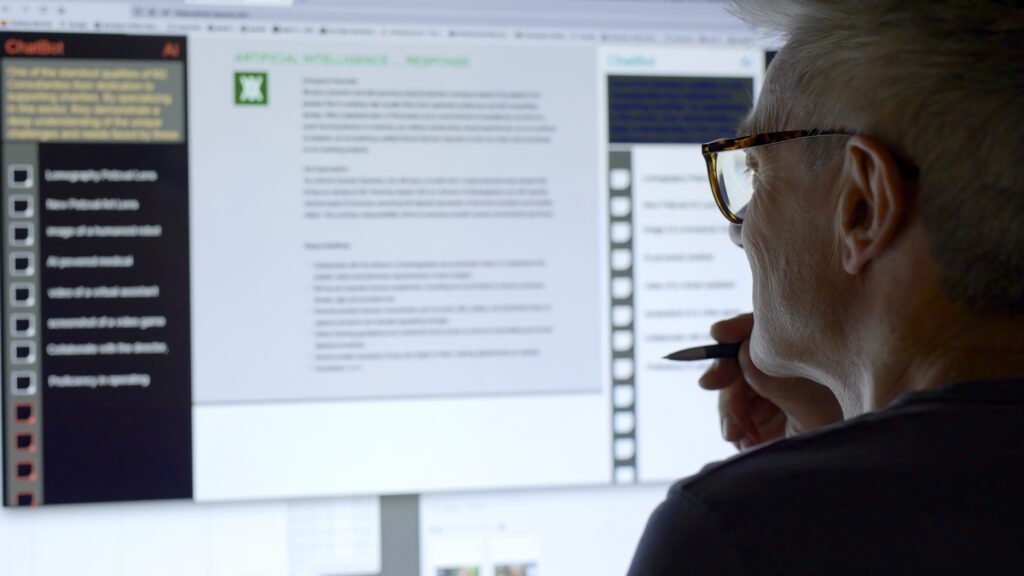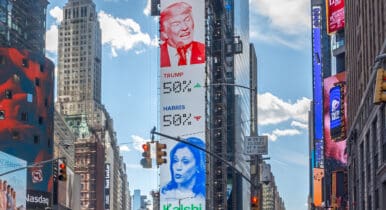The Year’s Best Creative and Design Advice

Image Credit: Laurence Dutton
Creative and design professionals will be critical to the success of campaigns and political organizations in 2024. Between the heightened demand for digital content and the need to stand out amid the anticipated deluge of political spending, “creative director” has become one of the most important roles in politics.
Here is some of the best advice that came out of C&E’s interview series with creative and design professionals in 2023 that’s relevant for campaigners in ’24:
C&E: When it comes to design and layout of fundraising emails, what does the data say about copy versus images and video?
Amy Bolick, Associate Director of Content Strategy, Rising Tide Interactive: When you have a fundraising email and you click on the link in the email and it then sends you to a landing page where you’re asked to put in your information and give a donation, our testing has shown repeatedly that a long landing page performs better than a short landing page. So it’s about having multiple lines of text explaining, one more time, why it is that you want the person to take action as opposed to just one or two lines of generic text. Over and over, we’ve seen that longer form and personalized content is more effective at activating people.
C&E: What do creative professionals need to be thinking about when it comes to using generative AI platforms like ChatGPT in their work?
Hillary Lehr, CEO of Quiller: I think for anything that is visual or audio that is produced having the consent of the candidate is important. We don’t recommend anybody build a program around ChatGPT for content generation for political use cases. One, because you don’t want it to get shut down in the middle of crunch time.
And secondly, because the technology is not trained specifically on your use case — your voice, your party, your talking points and the privacy permissions are not what they should be for people to be uploading a lot of content about their clients or candidates. And we saw this as an opportunity where we shouldn’t be relying on the large generative AI platforms for creating email, fundraising content or other types of email content.
C&E: What’s your advice for maxmizing reach on social media and what has worked for your clients?
Josh Scheinblum, Chief Creative Officer, Five Seasons Media: If you want to maximize your reach, your voice, you have to be doing video. The days of just creating a bunch of cookie-cutter graphics and sending them out to each campaign and changing the logos out and changing the candidate’s photo — throwing a bunch of pickles at the wall and praying that it’s gonna get some sort of success — those days are over. The candidates who are doing well, the campaigns that are doing well on social have a clear video strategy and they’re pumping out way more than just your typical, traditional campaign. When you’re fighting in the battlefield of digital real estate, the focus really needs to be on: Why is this content valuable to me?
C&E: Where do you look for design inspiration?
Karin Scott, designer and digital buyer at Narrative Strategies: Honestly, Reddit has a lot of graphic design threads. Typically, if I ran into an issue on a certain design platform, I’d Google it and there would always be a Reddit thread pop up. And it was kind of cool to see these vast communities where people are instantly jumping in and helping each other and helping people figure things out. You’ll also see Reddit threads where people are sort of showing their work and then inviting other people to provide feedback or creative suggestions, which I think is really awesome.
I think in a lot of professional communities you don’t necessarily have that cohesive bond across companies, but what I’ve found within the graphic design and creative community is that it’s very much a collaborative one. People want to help each other. And the sharing of knowledge and resources has been great to see and be involved in.
C&E: What’s your advice for telling cohesive stories in an age of very short online attention spans?
Rob Aho, Partner at BrabenderCox: The traditional story arc has changed radically. And the folks that don’t understand the changes to the story arc are not gonna be successful for very much longer. The [new] story arc looks a lot like a racing heartbeat. It’s moving around a lot. It’s got multiple peaks, unexpected shifts. And I believe that understanding how the story arc has changed is what it takes to hook voters and create a lasting connection with them.
There’s a temptation to be like, ‘Look, everybody’s got a really short attention span now, and everybody’s on TikTok and Twitter, and there’s no time to tell a good story.’ I think when people hear the word stories, they think it’s got to be this long-winded book or novel. But all that it takes to tell a good story is to have a narrative that pulls people in and interests them, and that’s what they’re going to remember.
C&E: What’s your advice for those trying to reach minority voters via digital channels?
Jacob Shlomo, Creative Director and Partner at Pacific Campaign House: It’s just making sure you are understanding that nuance also exists for minority audiences, and understanding that each of those audiences are going to respond differently to each message. It’s not gonna be just a simple, ‘I am putting a queer couple in the ad, and therefore everyone, all queer people, are supposed to respond to that.’ It’s important to understand who your audience is, and what you hope to achieve with this campaign, like through these visuals or through the copy. There’s a huge opportunity here to get more nuanced with how you’re speaking to voters.
It does take a little bit more of an investment in time and resources to understand where your focus has to be on these issues. But I think that the payoff is going to be worth it.
C&E: What is your advice for people managing creative professionals in the campaign industry?
Candice Dayoan, VP of Creative, 50+1 Strategies: Make sure you have paid fellowship and internship programs because there’s just so much to learn from people who are new. It’s easy to be like, this is how we’ve always done it, and it’s good to have that expertise. But being exposed to not necessarily younger, but people who are new — maybe because I was an unpaid intern, this is why I have strong feelings about it — you’re going to learn something from them. Everyone has a different perspective. Somebody took a chance on me, so who are you going to take a chance on? Be the person that gives that person a chance because I had a ton of those people and I wouldn’t be here if it wasn’t for them.
C&E: 2024 is going to be an extremely busy cycle for creatives. How can you cut down on rounds of edits and notes from clients?
Kate Conway, Chief Creative Officer, Assemble the Agency: When we set up on creative projects with clients, whether it’s a video or a logo design or anything else, we have an extensive conversation at the beginning to make sure that we’re all aligned about everything from the overall goals of the program to any particulars about the approach. Sometimes we document that in a creative brief. Sometimes it’s a quick email to make sure everybody’s on the same page. Sometimes we ask for specific examples if it seems like somebody’s got a particular vision they’re trying to achieve. Then we offer our creative take on things and we make sure that everybody is bought in on whatever direction we’re going to head in before we start any actual scripting or production or design work. That front end work is a huge time saver.
C&E: How can practitioners who haven’t done much creative testing in the past get started?
Madison Morris, Managing Director, IMGE: Anyone can now test A/B features in Meta Business Suite for organic content. That’s a great place to start to get some feedback on video or static content, headlines that you’re using in posts, and use that to inform what you can put budget behind. That is now the standard operating procedure for everything that we do — how we’re thinking about top-of-the-funnel all the way to the bottom, from making our acquisition campaigns smarter, better, cheaper, all the way to what converts people faster to get to that bottom of the funnel to where they convert.



